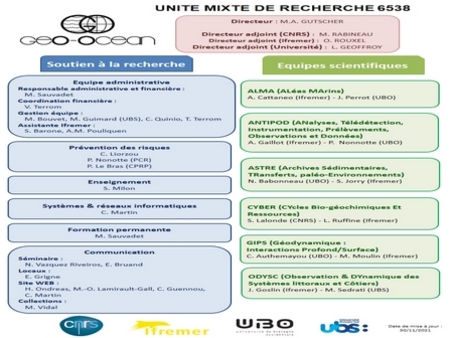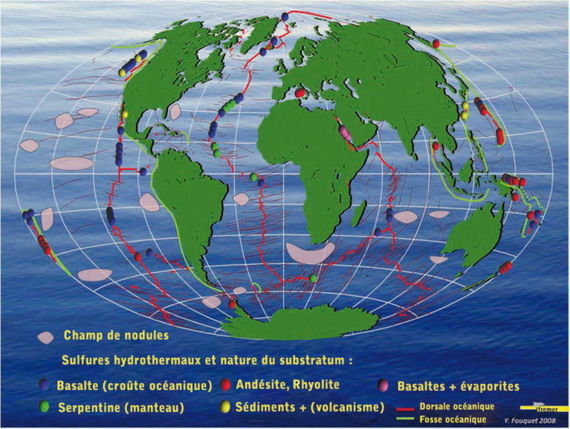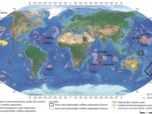Deep-sea mineral resources
Due to global population growth and the strong economic demand of emerging, heavily populated countries (China, India), humanity has a vital need to discover new natural resources.
Like energy, mineral resources are a key element in the development of industrialized economies. The surge in the price of raw materials and metals (nearly 350% in 3 years for copper and zinc) has led to the search for new terrestrial and marine deposits. The ocean covers 71% of the Earth’s surface (60% beyond 2 000 m), but this huge area is still relatively unknown. Its wealth may one day become essential to global needs in energy and raw materials.
Scientific exploration over the past thirty years has identified several geological and geochemical processes resulting in metal concentrations (polymetallic nodules, cobaltiferous encrustments and hydrothermal sulphides) and the genesis of potential original energy resources (methane hydrates, hydrogen) present in the deep sea. These discoveries open up new frontiers for the research and identification of mineral and energy resources in the ocean. It is noteworthy that hydrothermal sulphides, nodules, cobaltiferous clogging and hydrogen synthesis are linked to specific underwater processes that have no equivalent on the emerged continental crust.
- Hydrothermal mineralization can be highly concentrated in copper, zinc, gold, silver, cobalt, lead, barium, but also in rarer elements such as cadmium, indium, selenium, antimony, mercury, depending on the environmental context and the nature of the substratum. Due to the increase in boiling temperature with depth, the deepest fluids have a greater capacity to transport metals
- Cobalt-rich crusts and polymetallic nodules, mainly composed of iron oxide and manganese, are particularly interesting for their concentrations in nickel, cobalt and copper. They may also be rich in rare metals, platinum, titanium, cerium, zirconium, molybdenum and tellurium.
Information on the discovery by Japanese researchers of significant rare earth element stocks in the Pacific Ocean’s marine sediments became the subject of a large number of articles published in the world press in 2011. However, the reported concentrations (in the order of 0.1 to 0.2% of rare earth elements) are significantly lower than those of onshore ore (in the order of 5%) and similar to some cobaltiferous encrustments where rare earth elements are associated with other recoverable elements such as cobalt and platinum.
- In marine sediments, the maximum concentration of heavy rare earth elements such as dysprosium (72 g/t) is lower than that of terrestrial deposits (e.g. Mount Weld in Australia 500 g/t) and comparable to that of crustal structures (58 g/t). Dysprosium is one of the rare earth elements essential to permanent magnets and whose supply may become insufficient in the very short term. Knowledge of the actual potential of Polynesian sediments involves conducting a tighter sampling mesh to determine lateral continuity and variations in rare earth element concentrations.
The conclusion of the Japanese team that 1 km² of these sediment sludges would provide 1/5 of the world’s consumption (1377 tons in 2009) of rare earth elements seems premature. It is likely that the richest areas have not yet been discovered. This would involve taking existing collections of sediment crust and cores to look for high concentrations of heavy rare earth elements and conducting specific expeditions to define the extension of rich areas. In Polynesia, this type of expedition could easily be coupled with an expedition to study crustal structures.
Beyond the current mapping effort, France is particularly committed to conducting investigations to locate and create an inventory of mineral resources, such as siliceous aggregates and calcareous substances or placers, and potential energy sources in the extension of our EEZ.







